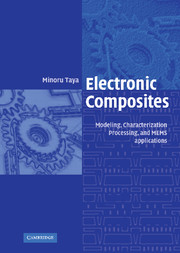Book contents
- Frontmatter
- Contents
- Preface
- Acknowledgements
- 1 Introduction
- 2 Applications of electronic composites
- 3 Foundations of modeling
- 4 Models for electronic composites based on effective medium theory
- 5 Resistor network model for electrical and thermal conduction problems
- 6 Percolation model
- 7 Lamination model
- 8 Engineering problems
- Appendix A Eshelby tensors
- Appendix B Physical constants and properties of materials
- References
- Author index
- Subject index
7 - Lamination model
Published online by Cambridge University Press: 03 May 2011
- Frontmatter
- Contents
- Preface
- Acknowledgements
- 1 Introduction
- 2 Applications of electronic composites
- 3 Foundations of modeling
- 4 Models for electronic composites based on effective medium theory
- 5 Resistor network model for electrical and thermal conduction problems
- 6 Percolation model
- 7 Lamination model
- 8 Engineering problems
- Appendix A Eshelby tensors
- Appendix B Physical constants and properties of materials
- References
- Author index
- Subject index
Summary
Laminated composites have been used extensively as printed circuit board (PCB) material in electronic packaging. Determination of the macroscopic properties of a PCB made of a laminated composite is a key step in designing a new PCB or selecting a PCB tailored for a specific packaging application. A laminated composite PCB consists of a number of laminae where each lamina itself is a composite made of discontinuous filler or continuous filler (straight fibers or woven fabrics). A lamination model is used to predict the overall properties of a laminated composite for a given set of properties of the laminae. It is assumed that the properties of each lamina are already obtained by experiment or predicted by a composite model such as the Eshelby model. Here, we apply the classical lamination theory only when a thin plate composed of laminae is subjected to thermomechanical loading and/or an electric field with the aim of finding the deflection of the plate and stress field within the laminae. The case of thermomechanical loading is important for the analysis of PCBs while that of an electric field relates to a piezoelectric laminated plate. Similarly, the behavior of electromagnetic waves in laminated composites provides key quantitative information in designing switchable windows for radomes and surface plasmon resonance sensors. In the following, we shall discuss first the classical lamination theory focusing on (i) mechanical behavior under hygro-thermomechanical loading, then extend it to (ii) the problem of a piezoelectric laminated composite subjected to an electric field, followed by (iii) stress analysis in a thin-coating–substrate system, and (iv) electromagnetic wave propagation in a layered medium.
- Type
- Chapter
- Information
- Electronic CompositesModeling, Characterization, Processing, and MEMS Applications, pp. 208 - 270Publisher: Cambridge University PressPrint publication year: 2005



